Miniaturized Photo-Ionization Fourier Deconvolution Ion Mobility Spectrometer for the Detection of Volatile Organic Compounds
Abstract
1. Introduction
2. Experimental Section
2.1. Chemicals and Reagents
2.2. Miniaturized Photo-Ionization Ion Mobility Spectrometer Drift Tube
2.3. Fourier Deconvolution Modulation Sequence Generation and Data Acquisition
2.4. Sample Preparation
3. Results and Discussion
3.1. Reduction in Ion Gate Switching Impact on Ion Mobility Spectra
3.2. Reconstructed Process of Ion Mobility Spectra
3.3. The Influence of Various Modulation Chirp Frequencies, Data Acquisition Rate and ADC Sampling Rate to the Performance of Miniaturized IMS Spectra
3.4. Analytical Performance of the Miniaturized Drift Tube
4. Conclusions
Supplementary Materials
Author Contributions
Funding
Institutional Review Board Statement
Informed Consent Statement
Data Availability Statement
Conflicts of Interest
References
- Babis, J.S.; Sperline, R.P.; Knight, A.K.; Jones, D.A.; Gresham, C.A.; Denton, M.B. Performance evaluation of a miniature ion mobility spectrometer drift cell for application in hand-held explosives detection ion mobility spectrometers. Anal. Bioanal. Chem. 2009, 395, 411–419. [Google Scholar] [CrossRef] [PubMed]
- Hill, H.H.; Siems, W.F.; Louis, R.H.S.; McMinn, D.G. Ion Mobility Spectrometry. Anal. Chem. 1990, 62, 1201A–1209A. [Google Scholar] [CrossRef] [PubMed]
- Steiner, W.E.; Klopsch, S.J.; English, W.A.; Clowers, B.H.; Hill, H.H. Detection of a Chemical Warfare Agent Simulant in Various Aerosol Matrixes by Ion Mobility Time-of-Flight Mass Spectrometry. Anal. Chem. 2005, 77, 4792–4799. [Google Scholar] [CrossRef] [PubMed]
- Kim, K.; Tsay, O.G.; Atwood, D.A.; Churchill, D.G. Destruction and Detection of Chemical Warfare Agents. Chem. Rev. 2011, 111, 5345–5403. [Google Scholar] [CrossRef]
- Vautz, W.; Hariharan, C.; Weigend, M. Smell the change: On the potential of gas-chromatographic ion mobility spectrometry in ecosystem monitoring. Ecol. Evol. 2018, 8, 4370–4377. [Google Scholar] [CrossRef]
- Hernández-Mesa, M.; Escourrou, A.; Monteau, F.; Le Bizec, B.; Dervilly-Pinel, G. Current applications and perspectives of ion mobility spectrometry to answer chemical food safety issues. TrAC Trends Anal. Chem. 2017, 94, 39–53. [Google Scholar] [CrossRef]
- Chen, H.; Chen, C.; Huang, W.; Li, M.; Xiao, Y.; Jiang, D.; Li, H. Miniaturized Ion Mobility Spectrometer with a Dual-Compression Tristate Ion Shutter for On-Site Rapid Screening of Fentanyl Drug Mixtures. Anal. Chem. 2019, 91, 9138–9146. [Google Scholar] [CrossRef]
- Armenta, S.; Esteve-Turrillas, F.A.; Alcalà, M. Analysis of hazardous chemicals by “stand alone” drift tube ion mobility spectrometry: A review. Anal. Methods 2020, 12, 1163–1181. [Google Scholar] [CrossRef]
- Ahrens, A.; Hitzemann, M.; Zimmermann, S. Miniaturized high-performance drift tube ion mobility spectrometer. Int. J. Ion. Mobil. Spectrom. 2019, 22, 77–83. [Google Scholar] [CrossRef]
- Teepe, M.; Kang, W.J.; Neyer, A.; Baumbach, J.I.; Schmidt, H. Miniaturized 63Ni Ion Mobility Spectrometer. Spectrometers 2001, 11, 173–176. [Google Scholar]
- Eiceman, G.; Stone, J. Peer reviewed: Ion mobility spectrometers in National Defense. Anal. Chem. 2004, 76, 390A–397A. [Google Scholar] [CrossRef]
- Eiceman, G.A.; Snyder, A.P.; Blyth, D.A. Monitoring of Airborne Organic Vapors Using Ion Mobility Spectrometry. Int. J. Environ. Anal. 1990, 38, 415–425. [Google Scholar] [CrossRef]
- Spangler, G.E.; Collins, C.I. Reactant ions in negative ion plasma chromatography. Anal. Chem. 1975, 47, 393–402. [Google Scholar] [CrossRef]
- Karasek, F.W.; Denney, D.W. Role of nitric oxide in positive reactant ions in plasma chromatography. Anal. Chem. 1974, 46, 633–637. [Google Scholar] [CrossRef]
- Reinecke, T.; Kirk, A.T.; Ahrens, A.; Raddatz, C.R.; Thoben, C.; Zimmermann, S. A compact high resolution electrospray ionization ion mobility spectrometer. Talanta 2016, 150, 1–6. [Google Scholar] [CrossRef]
- Peng, L.; Jiang, D.; Wang, Z.; Hua, L.; Li, H. Dopant-assisted negative photoionization Ion mobility spectrometry coupled with on-line cooling inlet for real-time monitoring H2S concentration in sewer gas. Talanta 2016, 153, 295–300. [Google Scholar] [CrossRef]
- Li, M.; Huang, W.; Chen, H.; Jiang, D.; Wang, W.; Xiao, Y.; Chen, C.; Li, H. Dopant assisted photoionization ion mobility spectrometry for on-site specific and sensitive determination of atmospheric ammonia. Sens. Actuators B Chem. 2021, 330, 129365. [Google Scholar] [CrossRef]
- Hong, Y.; Liu, S.; Huang, C.; Xia, L.; Shen, C.; Jiang, H.; Chu, Y. Simultaneous Improvement of Resolving Power and Signal-to-Noise Ratio Using a Modified Hadamard Transform-Inverse Ion Mobility Spectrometry Technique. J. Am. Soc. Mass Spectrom. 2017, 28, 2500–2507. [Google Scholar] [CrossRef]
- Im, E.; Yang, S.; Zhang, P.; Ni, K.; Guo, J.; Ou, G.; Lei, Y.; Wang, X. Development of an ion mobility spectrometer with UV ionization source to detect ketones and BTX. In Remote Sensing of the Atmosphere, Clouds, and Precipitation V; SPIE: Bellingham, WA, USA, 2014. [Google Scholar]
- Leonhardt, J.; Bensch, H.; Berger, D.; Nolting, M.; Baumbach, J.I. Determination of benzene, toluene, and xylene by means of an ion mobility spectrometer device using photoionization. In Proceedings of the Third International Workshop on Ion Mobility Spectrometry, Galveston, TX, USA, 16–19 October 1994; Volume 3301, pp. 49–56. [Google Scholar]
- Sielemann, S.; Baumbach, J.I.; Schmidt, H.; Pilzecker, P. Quantitative analysis of benzene, toluene, and m-xylene with the use of a UV–ion mobility spectrometer. Field Anal. Chem. Technol. 2000, 4, 157–169. [Google Scholar] [CrossRef]
- Knorr, F.J.; Eatherton, R.L.; Siems, W.F.; Hill, H.H. Fourier Transform Ion Mobility Spectrometry. Anal. Chem. 1985, 57, 402–406. [Google Scholar] [CrossRef]
- Davis, A.L.; Reinecke, T.; Morrison, K.A.; Clowers, B.H. Optimized Reconstruction Techniques for Multiplexed Dual-Gate Ion Mobility Mass Spectrometry Experiments. Anal. Chem. 2019, 91, 1432–1440. [Google Scholar] [CrossRef]
- Schrader, R.L.; Marsh, B.M.; Cooks, R.G. Fourier Transform-Ion Mobility Linear Ion Trap Mass Spectrometer Using Frequency Encoding for Recognition of Related Compounds in a Single Acquisition. Anal. Chem. 2020, 92, 5107–5115. [Google Scholar] [CrossRef]
- Edward, E.T. External second-gate Fourier transform ion mobility spectrometry: Parametric optimization for detection of weapons of mass destruction. Sensors 2004, 4, 1–13. [Google Scholar]
- Kwantwi-Barima, P.; Reinecke, T.; Clowers, B.H. Increased ion throughput using tristate ion-gate multiplexing. Analyst 2019, 144, 6660–6670. [Google Scholar] [CrossRef]
- Clowers, B.H.; Belov, M.E.; Prior, D.C.; Danielson, W.F.; Ibrahim, Y.; Smith, R.D. Pseudorandom Sequence Modifications for Ion Mobility Orthogonal Time-of-Flight Mass Spectrometry. Anal. Chem. 2008, 80, 2464–2473. [Google Scholar] [CrossRef][Green Version]
- Szumlas, A.W.; Ray, S.J.; Hieftje, G.M. Hadamard Transform Ion Mobility Spectrometry. Anal. Chem. 2006, 78, 4474–4481. [Google Scholar] [CrossRef]
- Yu, J.; Jing, G.; Li, W.; Liu, W.; Okonkwo, J.N.; Liu, W.; Hill, H.H. Simulating, Predicting, and Minimizing False Peaks for Hadamard Transform Ion Mobility Spectrometry. J. Am. Soc. Mass Spectrom. 2020, 31, 1957–1964. [Google Scholar] [CrossRef]
- Davis, A.L.; Liu, W.; Siems, W.F.; Clowers, B.H. Correlation ion mobility spectrometry. Analyst 2017, 142, 292–301. [Google Scholar] [CrossRef]
- Hu, W.; Meng, Q.; Lu, Y.; Xu, Y.; Nwadiuso, O.J.; Yu, J.; Liu, W.; Jing, G.; Li, W.; Liu, W. Fourier Deconvolution Ion Mobility Spectrometry. Talanta 2022, 241, 123270. [Google Scholar] [CrossRef]
- Ahrens, A.; Möhle, J.; Hitzemann, M.; Zimmermann, S. Novel ion drift tube for high-performance ion mobility spectrometers based on a composite material. Int. J. Ion Mobil. Spectrom. 2020, 23, 75–81. [Google Scholar]
- Leasure, C.S.; Fleischer, M.E.; Anderson, G.K.; Eiceman, G.A. Photoionization in air with ion mobility spectrometry using a hydrogen discharge lamp. Anal. Chem. 1986, 58, 2142–2147. [Google Scholar] [CrossRef]
- Cheng, S.; Wang, W.; Zhou, Q.; Chen, C.; Peng, L.; Hua, L.; Li, Y.; Hou, K.; Li, H. Fast Switching of CO3–(H2O)n and O2–(H2O)n Reactant Ions in Dopant-Assisted Negative Photoionization Ion Mobility Spectrometry for Explosives Detection. Anal. Chem. 2014, 86, 2687–2693. [Google Scholar] [CrossRef] [PubMed]
- Jiang, D.; Li, E.; Zhou, Q.; Wang, X.; Li, H.; Ju, B.; Guo, L.; Liu, D.; Li, H. Online Monitoring of Intraoperative Exhaled Propofol by Acetone-Assisted Negative Photoionization Ion Mobility Spectrometry Coupled with Time-Resolved Purge Introduction. Anal. Chem. 2018, 90, 5280–5289. [Google Scholar] [CrossRef] [PubMed]

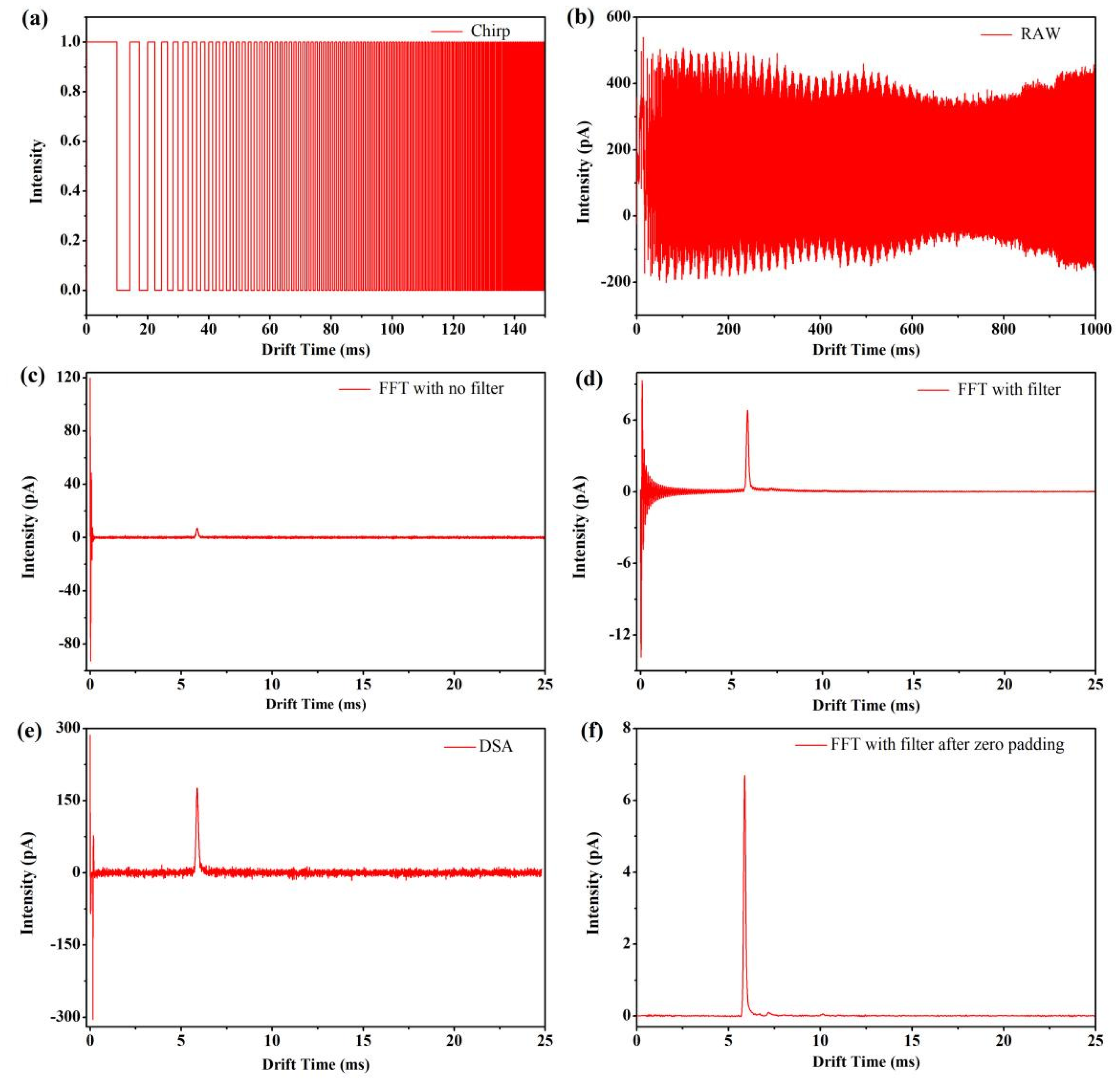
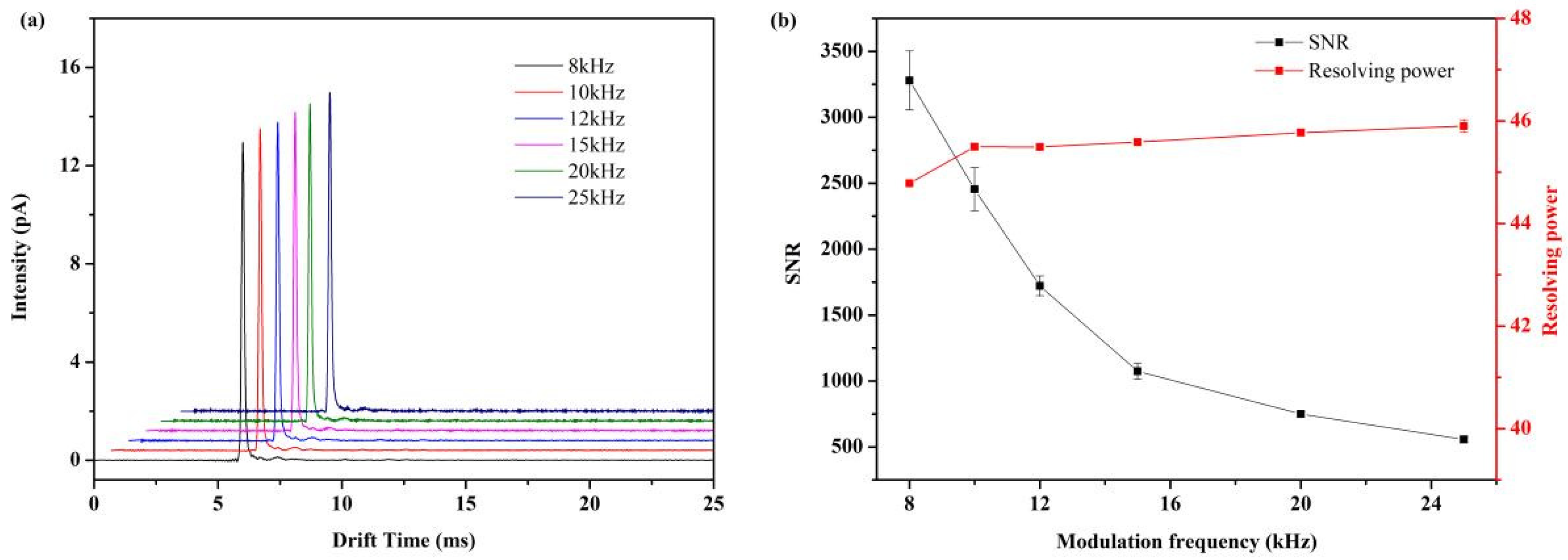
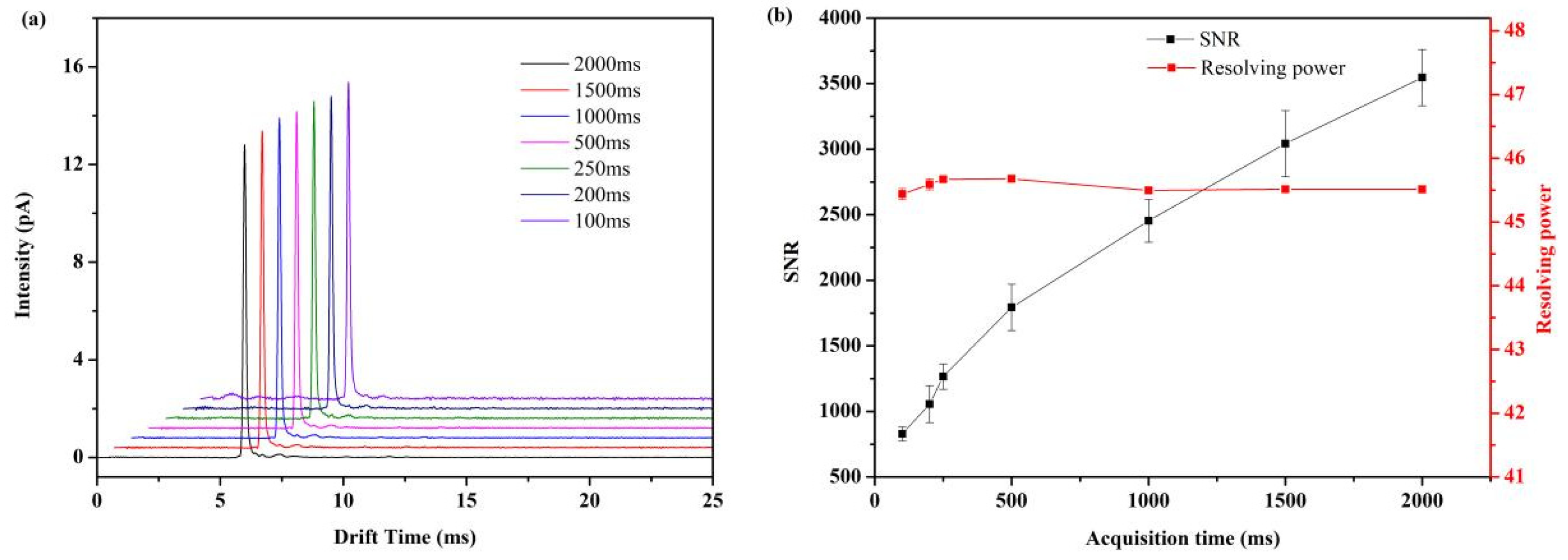
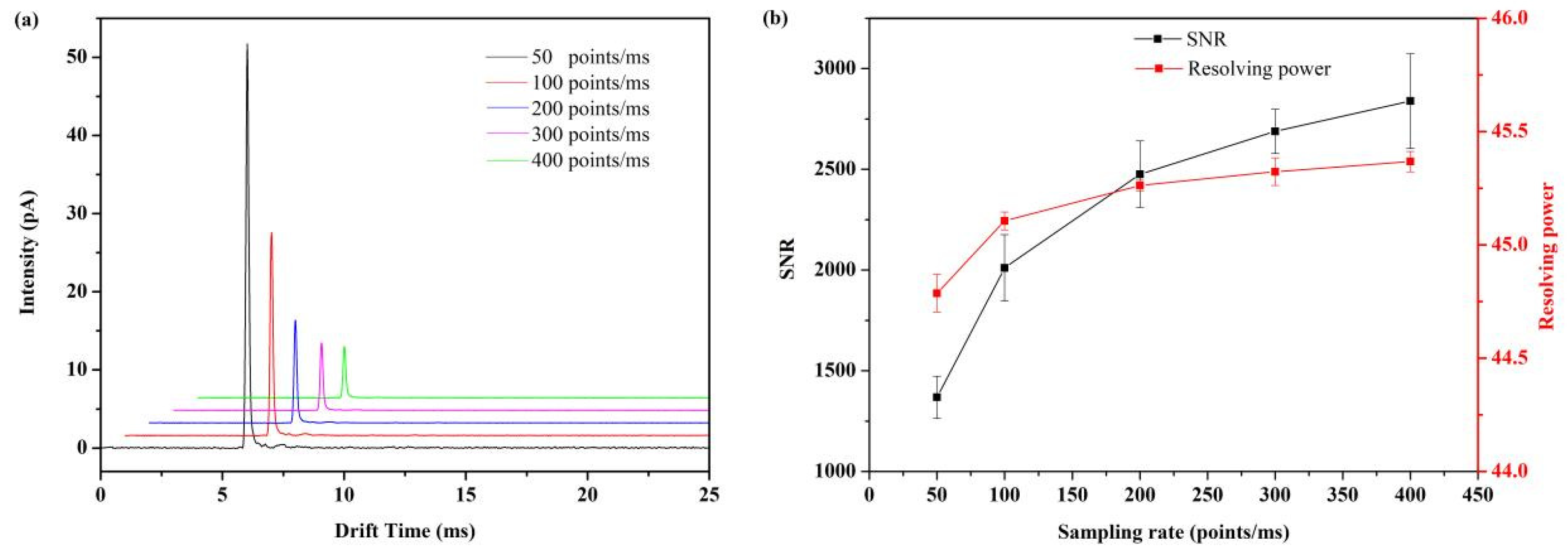
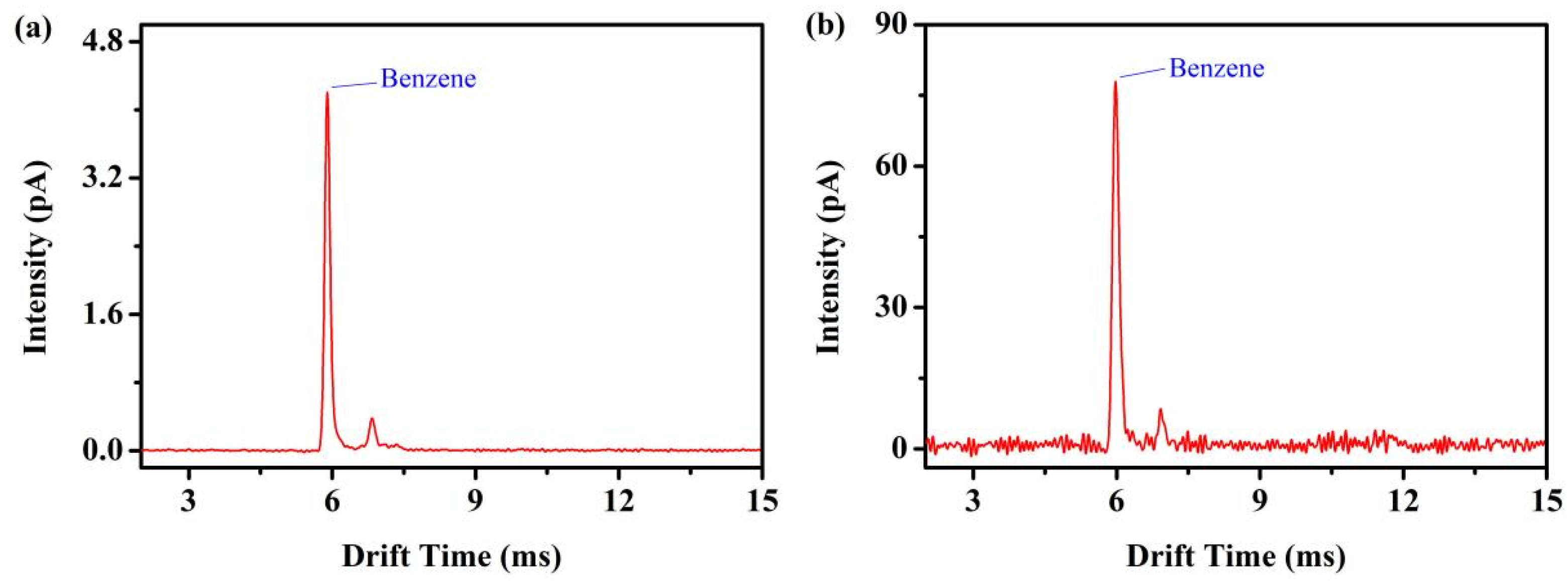



| Parameter | PI-IMS |
|---|---|
| Length of Drift Region | 41 mm |
| The inner diameter of the drift tube | 10 mm |
| Electrical Field Strength | 383 V/cm |
| Gate Voltage Differences | ±25 V |
| Gate Pulse Frequency | 0~10 kHz |
| Gain of Amplifier | 5 × 108 V/A |
| Ionization Source | 10.6 eV UV Lamp |
| Drift Gas Flow Rate | 100 mL min−1 |
| Carrier Gas Flow Rate | 30 mL min−1 |
| Temperature | 25 °C |
| Pressure | 103.0 kPa |
Publisher’s Note: MDPI stays neutral with regard to jurisdictional claims in published maps and institutional affiliations. |
© 2022 by the authors. Licensee MDPI, Basel, Switzerland. This article is an open access article distributed under the terms and conditions of the Creative Commons Attribution (CC BY) license (https://creativecommons.org/licenses/by/4.0/).
Share and Cite
Yang, B.; Yu, J.; Liu, W.; Jing, G.; Li, W.; Liu, W. Miniaturized Photo-Ionization Fourier Deconvolution Ion Mobility Spectrometer for the Detection of Volatile Organic Compounds. Sensors 2022, 22, 5468. https://doi.org/10.3390/s22155468
Yang B, Yu J, Liu W, Jing G, Li W, Liu W. Miniaturized Photo-Ionization Fourier Deconvolution Ion Mobility Spectrometer for the Detection of Volatile Organic Compounds. Sensors. 2022; 22(15):5468. https://doi.org/10.3390/s22155468
Chicago/Turabian StyleYang, Binwang, Jianna Yu, Wen Liu, Guoxing Jing, Wenshan Li, and Wenjie Liu. 2022. "Miniaturized Photo-Ionization Fourier Deconvolution Ion Mobility Spectrometer for the Detection of Volatile Organic Compounds" Sensors 22, no. 15: 5468. https://doi.org/10.3390/s22155468
APA StyleYang, B., Yu, J., Liu, W., Jing, G., Li, W., & Liu, W. (2022). Miniaturized Photo-Ionization Fourier Deconvolution Ion Mobility Spectrometer for the Detection of Volatile Organic Compounds. Sensors, 22(15), 5468. https://doi.org/10.3390/s22155468






